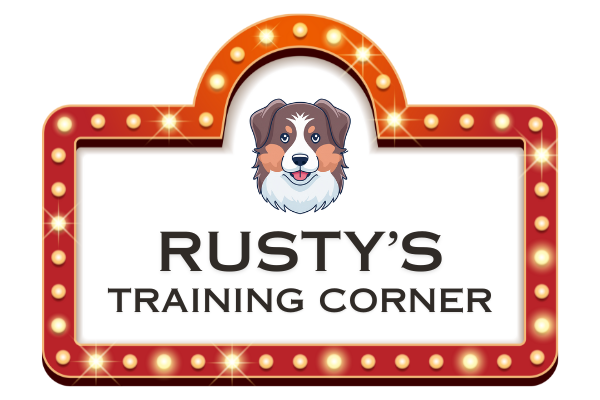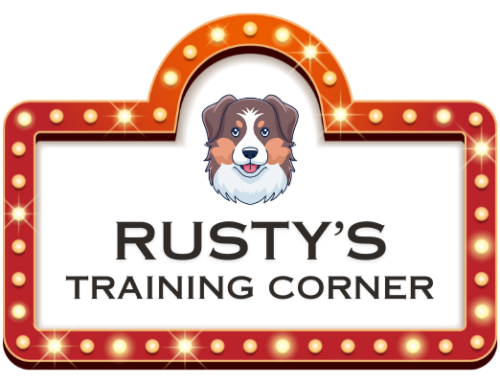- All dogs will pull on a tense leash… It’s a natural reflex response…
- Many dogs pull on leash because 1) they can, and 2) because we follow…
- The Reward to the dog for walking on a loose leash is the walk itself…
Ground Rules
- Have the appropriate leash for your dog…
- Pick a side, left or right… Center is not a side. If you do not get your dog accustomed to walking on a certain side, you might never get them to walk on a loose leash.
- Be certain “everybody” that walks your dog, walks them on the same side as you…
- Have a consistent walk word (cue), but not the word “come”, which many people say to their dogs much too often as a walk word. That will confuse the dog when we are attempting to get them to “come when called”.
- I use “Lets go”, or “Lets Walk”, or just “Walk”…
Pulling on leash is a “Natural Reflex Response”. A Human pulling on the leash will usually cause the Dog to “Pull Back”.
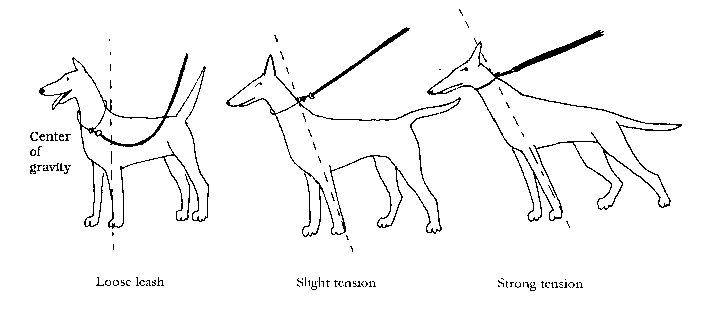
Don’t give your dog anything to lean against. The more tension you apply trying to hold your dog back, the more he shifts his weight forward to compensate. Keep the leash slack!
Standing Like a Tree
The first commandment of leash training: DO NOT PROCEED FORWARD IF YOUR DOG IS APPLYING TENSION TO THE LEASH.
Simply STOP every single time you note that the dog has put the slightest tension on the leash and the pulling will go away. (Yeah, right.) No, honest – It really, really works! The truth is, that if you tire your dog out first with a good game of fetch and then take him for a walk in a quiet non-distracting place every day this week with only ONE goal: to walk without tension, and you absolutely refuse to take a single forward step when you feel tension on the leash, he will discover that pulling doesn’t get him anywhere, and that the tension is a cue to slacken the lead. You will see the lightbulb go on when he realizes this. If you are consistent and don’t give up, he will learn it. He will have good days and bad, but if you are diligent he will figure it out.
Don’t walk forward if there is tension on the leash.
When the dog applies ANY tension to the leash at all ….

Immediately stop…
Drop with your guide hand and hold with your other, allowing the dog to go out to the end of the leash…
Stand Like a Tree…
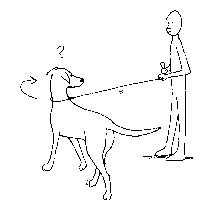
When the dog turns to see what happened to you, and relaxes the tension in the leash, click (if using a clicker to train) or simply use your verbal mark, like saying “yes”, praise for his attention …. and encourage the dog back next to you – if necessary, take a few steps backward.
As soon as the dog is in the magic spot next to your leg, continue praising, give food rewards, make it the best possible place in the world to be. If he loses concentration and puts any tension on the leash at all, stop without warning and repeat the above sequence.
Alternate Methods
- If you are still having trouble with your dog pulling on the leash, and time prevents you from utilizing the “Standing Like a Tree” method, or your dog just doesn’t seem to be “getting it”, the following alternative methods might be helpful.
- Your dog pulls because he’s interested in something and wants to get to it, usually faster than you do!
Diversion Stops
- Use your walk cue together with your correction cue/tone.
HERE’S THE TECHNIQUE STEP-BY-STEP:
Start your walk utilizing your verbal walk cue, like “Lets Go”. As soon as there is tension on the leash, use your correction word/tone (ahhh) and pull on the leash returning the dog to your hip. Wait just a second, and start your walk again. Do this rapidly each time there is tension on the leash. After a few rounds of this type of correction, the dog will usually look up at you with a bewildered look, almost like they are saying “what’s going on here”! What they are really doing is looking for direction from you. This is your opportunity to start verbally praising as you are walking with your dog. Make sure there is no tension on the leash while you are praising. This usually results in a loose leash.
Diversion Turn-a-Rounds
- Diversion Turn-A-Rounds totally breaks the dog’s concentration and deprives them of getting to whatever it is they are interested in. After a few turn-a-rounds, you’ll usually get this puzzled look from the dog, kind of like they’re saying to you “WHAT ON EARTH ARE YOU DOING?”, “every time I go that direction, you take me somewhere else. The good news is that nearly every time you get “the look” from your dog, you’ll notice that you’ll have a loose leash. This is your opportunity to start praising you dog (verbally only), but be sure to use your high falsetto voice (your best “Miss Doubtfire”) voice…
HERE’S THE TECHNIQUE STEP-BY-STEP:
What if you stop and he just keeps pulling? Stop for a couple of seconds and wait, if your dog continues to strain like a maniac, turn abruptly and walk the other direction with your dog (imagine you are facing 12 on the clock, you are going to turn and head for 6 o’clock.) Always turn “away from your dog” and bring them around you, not the other way around. If you turn toward the dog, you’ll most likely fall over them! The direction change will set him off balance and he will turn toward you, as he catches up, PRAISE with your best “Miss Doubtfire” voice… and while there is a loose leash, keep praising as you walk in the other direction. Most often, your dog will enjoy the praise and will even go from a pull on the leash, to a happy prance. If this continues, you might even consider delivering a treat while the dog is in position – next to the seam of your pantleg, all the while using high value praise, then continue on your way. If he pulls again, repeat your turn-a-round and go the opposite direction.

The advice and tips provided in this dog training blog post are based on general best practices and personal experiences. Please consult a professional dog trainer or veterinarian for specific issues or before starting any new training regimen with your dog.


